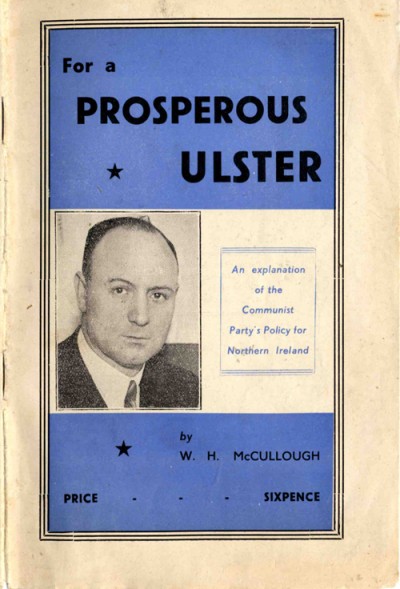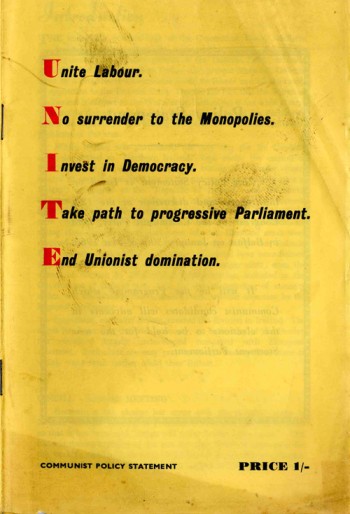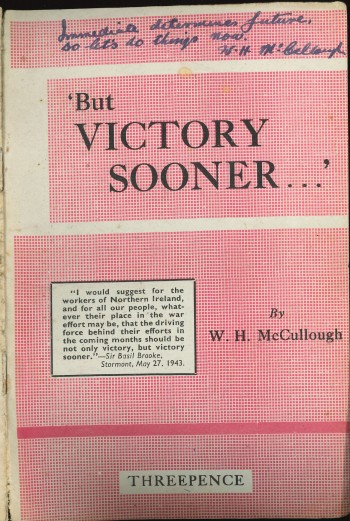For a Prosperous Ulster
An Explanation of the Communist Party’s Policy for Northern Ireland

| Date: | 1944 |
|---|---|
| Organisation: | Communist Party of Northern Ireland |
| Series: | Communist Policy Pamphlets, Number 1 |
| Author: | W. H. McCullough |
| View: | View Document |
| Discuss: | Comments on this document |
| Subjects: |
Please note: The Irish Left Archive is provided as a non-commercial historical resource, open to all, and has reproduced this document as an accessible digital reference. Copyright remains with its original authors. If used on other sites, we would appreciate a link back and reference to The Irish Left Archive, in addition to the original creators. For re-publication, commercial, or other uses, please contact the original owners. If documents provided to The Irish Left Archive have been created for or added to other online archives, please inform us so sources can be credited.
Commentary From The Cedar Lounge Revolution
30th July 2012
This document is perhaps the oldest one in the Archive, dating back to the Second World War period. It was issued by the Communist Party of Northern Ireland. The CPNI emerged from the suspension of the Communist Party of Ireland in 1941 (an event which ultimately led to the eventual emergence of two CP formations on the island, the Irish Workers Party in the South in 1948 and the CPNI in the North). This state of affairs was not to be altered until the merger of the two parties as the CPOI in 1970.
The document itself is slightly smaller than A5 and sixteen pages long, it was written with the end of the war in sight. Therefore it notes that ‘Future prospects are bright. Victory is in sight but it is not yet won’.
And it notes that:
Stalin’s wise declaration that a wounded beast can be very dangerous is a timely reminder that all is not over; the beast has to be followed into its lair and destroyed. After Germany Japan will have to be dealt with. The people have learned innumerable lessons from the war. They have been inspired by the glorious achievements of the mighty Socialist Power, the Soviet Union. They have seen that when united internally and with the peoples of countries inspired by the same ideals of freedom and democracy against a common enemy and for a common cause, the dark forces of fascism can be conquered.
And…
The value of the cooperative effort has manifested itself to millions as a new power in society, even though at times co-operative effort was restricted and limited by a section of reactionary employers.
It further notes that:
In Northern Ireland also there will be great work of reconstruction. Bombed areas must be rebuilt. Houses will have to be constructed on modern lines, providing the greatest possible opportunities for the people living in them to lead a healthy life.
In relation to the North it continues:
The greatest obstacle to the unity of the people and the full mobilisation of the resources of NI is the Unionist Party. The Government has made no effort to unite the people, and the war effort of the Province left much tone desired. The anger of the people eventually drove Andrews and his gang out of office, a new Unionist Party Government was formed under the leadership of Sir Basil Brooke and pledged to conduct a policy for the utmost prosecution of the war.
There is some interesting material on the ‘Imperial Contribution’, the funding given to NI by the British Treasury. There is also a strong focus on industrialisation and on the prospects for industrial growth in relation to shipbuilding, engineering, aircraft and linen. It argues in relation to these and other areas that ‘it is obvious that a considerable amount of capital expenditure will be required and complete re-organisation must take place’.
It also argues for Social Insurance, modelled on the Beveridge Plan, Health Services and Education. In relation to the last it proposes that ‘dual control be abolished; religious instruction to be at the option of the parents, and teachers have the right to teach religion or not, according to their wishes and conscience’. It is reasonable to suggest that overall the leaflet does not directly address the issue of national identity as such in any detail. It does reference the demand that:
In fighting for this programme for the people, labour must ensure that the people obtain every opportunity to exercise their democratic rights. Labour must ensure that at the earliest opportunity undemocratic legislation, such as the Special Powers Act, is removed from the statute book; that undemocratic actions such as the gerrymandering of constituencies and sectarian discrimination against a section of the people is ended.
And it continues:
The labour movement must demand that all those elected to represent the people carry out their responsibilities. There must be an end to Parliamentary absenteeism and the virtual disenfranchisement of many electors through the abstentionist policy of a section of Nationalist members of Parliament.
But in terms of the island as a whole it seeks ‘a Government that will be a good neighbour of the Government of Southern Ireland’.
Overall an useful guide to the orientation of the Communist Party in Northern Ireland during this period.
More from Communist Party of Northern Ireland
Communist Party of Northern Ireland in the archive


Comments
No Comments yet.
Add a Comment
Comments can be formatted in Markdown format . Use the toolbar to apply the correct syntax to your comment. The basic formats are:
**Bold text**
Bold text
_Italic text_
Italic text
[A link](http://www.example.com)
A link
You can join this discussion on The Cedar Lounge Revolution
By: Mark P Tue, 31 Jul 2012 19:19:45
In reply to Mark P.
Right, I got Milotte’s book out and, unsurprisingly, it has a lot to say about the dissolution of the CPI in the South:
1) It came in the wake of the ridiculous twists and turns of Comintern policy towards the war. These had particularly sharp consequences for the CP in Ireland because they determined the approach to be taken towards Britain at any given time. At the time of the dissolution, the CP’s patriotic support for the war in the North had left it even more isolated than before in the South.
2) The dissolution was controversial, and was initially rejected by the Southerners, with opposition led by Barney Larkin, then a rank and file member, but was rammed through narrowly at a second meeting. By this point there was only a small Dublin branch still operating.
3) As discussed above, the “dissolution” was indeed a dissolution only of the open party. They stayed organised and the plan was to operate as an entryist faction.
4) They met with some initial success, particularly in Dublin, where they worked with a number of non-party left wingers, some of them ex-CP like Jim Larkin Sr and Jr, but most of them without such a background. Their basic underlying line was pro-coalition(!) and anti-neutrality(!) but this was more openly expressed by the Northern CP than by the Southern entryists themselves, presumably because such views were less than popular with their allies.
5) The success of this left within Labour led to witchhunts in the national press and within the party apparatus. The presence of “communists” (a term used to also include Larkin and others outside of the CP entryists) was in fact the key public issue in the National Labour split, although behind the scenes the ambitions of the ITGWU for hegemony over the Labour movement and antipathy towards Larkin were also factors.
6) As expulsions continued and the strength of the left in Dublin and Cork Labour Party organisations was thoroughly smashed, the ex-CP was increasingly disoriented and inactive, with its members split between a decreasingly organised remnant within Labour and an expelled bunch who did not create a new open organisation.
Reply on the CLR
By: Mark P Tue, 31 Jul 2012 19:37:57
In reply to Mark P.
Just to add, these are my summaries of quite a lengthy section which I scanned quickly. I could easily be misrepresenting Milotte on important details.
Reply on the CLR
By: WorldbyStorm Tue, 31 Jul 2012 19:44:43
In reply to Mark P.
Bloody hell, that’s fast. That’s really handy as a precis. Thanks a million. I’m really intrigued now to reread waht there is on the period about their entry into the LP and the subsequent shenanigans. One small question, re the term ‘coalition’ do you mean in the South and in relation to FG (I only ask because FF remained pre-eminent until 48)? So did they push for that and if so why – was it that FG was seen as anti-neutrality, or less pro-neutrality?
Reply on the CLR
By: WorldbyStorm Tue, 31 Jul 2012 19:45:56
In reply to Mark P.
BTW! On Monday next there’s a really interesting CP associated doc that took some doing to get. Watch this space.
Reply on the CLR
By: Ed Tue, 31 Jul 2012 20:34:22
In reply to Mark P.
Just read back over Emmet O’Connor’s account of the same period in ‘Reds and the Green’; a couple of things worth adding:
1) According to O’Connor, the decisive pressure for the Dublin branch to dissolve came from the British CP, which had taken on responsibility for ‘minding’ the Irish communists as communication between Ireland and the Comintern leadership was very difficult once war broke out. The CPGB didn’t think the southern CP could be relied on to follow an anti-neutrality line (O’Connor thinks they were probably mistaken about that).
2) The ‘pro-coalition’ line was for a Labour-FF government to be formed that would take Ireland into the war on the Allied side (roughly similar, presumably, to the Tory-Labour coalition in Britain that the CPGB was supporting at the time).
Reply on the CLR
By: Mark P Tue, 31 Jul 2012 21:33:23
In reply to Mark P.
On the two points added by Ed:
1) MiIlotte says that at least one account, published in the main British Trotskyist group’s newspaper, suggests that at the second meeting, where the CPI leadership managed to get their entryist strategy through, the decisive votes came from visiting CPGB members.
2) They were generally in favour of a Labour – Fianna Fail coalition although this was not supported by the leftists they were working with in Labour. By and large these people wanted an independent socialist policy for Labour. This put the CP-entryist people in the South in a somewhat awkward situation, and for that reason and also due to the impact of censorship they generally much more circumspect about their desire that this coalition would bring Ireland into the war than the CP in the North was. Up there of course they weren’t alienating anybody by trenchantly calling for an FF-Lab coalition to end Irish neutrality.
At some stages, the CP in the North, looked more favourably on Fine Gael, in 1942 calling for a coalition including “the best elements” of both FF and FG alongside Labour. And in 1944 it welcomed Richard Mulcahy(!) becoming leader of FG as they saw him as pro-war. But as a whole the orientation was towards a Lab-FF coalition.
3) I agree with O’Connor’s suspicion that the British CP were wrong if they feared that the Irish CP would fail to do as they were told. They had at that point faithfully followed the Comintern line through all of its contortions and 180 degree reversals on the Popular Front and the war, and while those changes had sometimes triggered dissent, as the move into Labour itself did, ultimately they always followed the line.
Reply on the CLR
By: Mark P Tue, 31 Jul 2012 21:39:11
In reply to Mark P.
Jesus, “on the two points…” immediately followed by numbered points 1, 2 and 3. Not my most numerate day.
I forgot to add, in response to WbS, I agree that it’s a really useful book and it’s a real shame that it’s out of print. There’s no other rigorous, detailed, treatment of the history of the CPI. And what an interesting history it is!
Reply on the CLR